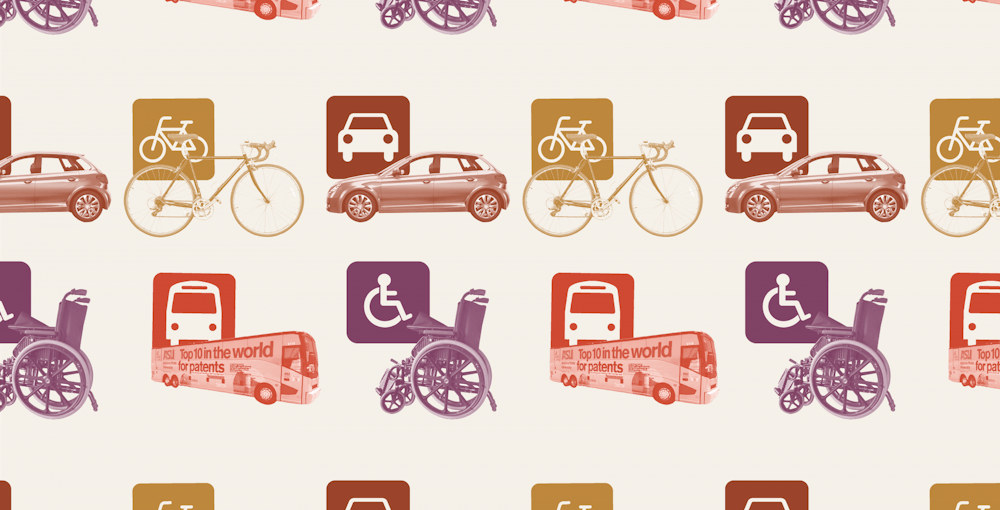At 6:30 a.m. the sun isn't quite up yet, but Autumn Baker is.
It's Monday, and the sophomore studying biomedical sciences is getting ready for a day of classes that will last 12 hours and span two different campuses, a little over 20 miles apart.
For many students, a 12-hour school day would be more than enough time to get ahead on their homework and study for an upcoming exam. But Baker will spend between four to five hours of her day locked in a liminal, unproductive limbo, commuting between her home, West and Tempe campuses.
JC Porter has already been up for an hour. He hit the road at 6 o'clock sharp. Hopefully, he'll make it to his office at ASU Parking and Transit Services by 7:15 a.m., just in time to shower and cool down before work.
For the past eight years, Porter has biked to work every day. When he travels to Tempe, he cycles 20 miles each way, a total of 40 miles over two-and-a-half hours.
Cody Wright, on the other hand, is in no rush. The junior psychology student lives in an apartment adjacent to the Tempe campus and can make his way to the Memorial Union in just 10 minutes — which, he notes, is significantly faster than many of his peers.
"I can cruise in this at 6 miles an hour," Wright said, gesturing to his motorized wheelchair with a grin. "That's a little more than double the walking speed of most people."
Thousands of students, faculty and staff commute daily to ASU's campuses; Baker, Porter and Wright represent a microcosm of the community. Their experiences shine light on a variety of urban and social issues facing ASU community members today, from rent inflation to accessible and sustainable transportation.
Autumn
Baker leaves the house at 7 a.m. to make it to her 8 a.m. on the West campus by car. At 11:30 a.m., she takes the ASU shuttle from West to Tempe for her 1:30 p.m. class. Afterward, she grabs the 4:30 p.m. shuttle back to West, then drives home. She’s usually back in time for dinner at 6:30 p.m.
In all, she spends around two hours of the day in her car. It's a tedious and monotonous ride, hardly a relaxing experience.
About two more hours are dedicated to waiting for and riding ASU's intercampus shuttles. This is when Baker attempts to find some "me time;" she listens to music, scrolls on TikTok or works on her latest crochet project, trying her best to reclaim some of her day lost to her commute.
"The days that I forget my headphones are the worst days," she said. "You just have to sit there and you can't do anything."
Her commute is mostly sedentary, but it can be hard on her body. Baker has medical issues with her hips and knees, which can make long bus and car rides miserable.
"Sitting in one position for a long amount of time is really painful," she said. "When I'm coming off the bus, I'll be hobbling back to my car just to sit for longer."
Though her commute is draining, she essentially has no choice in the matter — several of her required courses are only available on the Tempe campus. She's one of many ASU students who take classes on and commute between multiple campuses throughout the week.
Baker lives in her childhood home in Glendale, saving money on rent and caring for her grandparents. She pays for college using scholarship money, which doesn't cover the cost of on-campus housing.
"It would be a lot simpler to live on campus or near campus, but it's not particularly a choice," Baker said. "It's mainly the money."
With the exorbitant and rising cost of housing in Tempe and Phoenix, living close to campus is becoming less and less accessible for many students.
Tempe is currently facing an affordable housing crisis. Across the Valley, the cost of housing is skyrocketing, increasing by 20-30% in some areas. Metro Phoenix rents had already risen by nearly 80% from 2016-2021, and a national inflation boom ushered in by COVID-19 has devastated the market even further.
READ MORE: Tempe continues to grow while housing demand intensifies
On top of her commute, Baker also works between 18-to-25 hours per week. Free-time is a luxury for her; she frequently has to cut into her sleep schedule, doing homework "really late at night" just to keep up.
"I think that living on campus is a privilege, for both schoolwork and being able to make friends and meet people — to get the full college experience," she said.
About 80% of ASU students live in off-campus housing, according to U.S. News and World Report. The University encourages freshmen to live in University housing if they're able, citing research that shows higher success rates among on-campus students.
Baker would love to be more involved and make more friends at school, but her commute and living situation leave her feeling detached from the on-campus student body. People often don't talk to her during class or on the shuttles. She said it sometimes feels isolating.
"I wish that people knew how hard it is to talk to strangers."
JC
If Baker's commute is characterized by discomfort, boredom and a lack of agency, Porter's is nearly the opposite. While cycling at the beginning and end of his work day, he finds a peaceful, sometimes euphoric headspace.
"You get a little bit of me time back when you're on your bike, whereas when you're in the car, frustrations and everything else can still be in there with you, built up," Porter said.
He spends over two hours commuting every day, but he doesn't see it as time wasted or lost — in fact, he figures he's actually saving time others might dedicate to the gym. The 40 miles he bikes each day make for a more-than-adequate daily exercise regimen.
When asked whether there is an environmentalist rationale to his cycling habit, Porter chuckled.
"I mean, one could be made, but that's not the reason I do it."
As associate director of commuter services at ASU, Porter oversees the University's bike program and tries to "walk the walk." He also estimates he’s saving money by not driving, though regular maintenance and tire replacements are still a significant expense over time.
Over the past eight years, Porter has worked with the city of Tempe and ASU to improve and synchronize bike routes throughout the area. In 2019, the city was declared a "Gold-Level Bicycle Friendly Community," with around 4% of residents cycling to work.
A significant percentage of ASU community members get to work without a motorized vehicle at all. According to a 2021 ASU survey provided by Porter, in 2019, 33% of students, 26% of faculty and 13% of staff commuted to work by "carbon-free" means, such as walking, cycling or skateboarding. In 2021 the numbers were reduced in all categories due to COVID-19.
Porter has also found community among other cyclists. "You meet the nicest people while biking," he said. He encourages everyone to try it out if they can, though he’s quick to acknowledge there are some physical and financial privileges inherent in the activity.
"You should see the world at bike speed," he said. "It's a whole different world when you're going 15 or 20 miles per hour and really interacting with the environment."
READ MORE: Major construction projects surrounding ASU Tempe frustrate commuters
Cody
Wright's commute is the shortest of the three by far. After leaving his apartment, he only has to cross two streets before he's on the Tempe campus and on his way to class, all in a matter of minutes.
Overall, Wright said ASU's Tempe campus is well designed for navigating in a wheelchair, though it's not perfect. As a member of the Accessibility Coalition, he has helped advocate for more accessible infrastructure, such as fixing broken elevators or automated doors.
Even on his brief commute he has encountered obstacles, such as poorly designed curb ramps on the intersection of Rural Road and Terrace Mall. He thinks the bumpiness of the ride could potentially be dangerous if he wasn't as experienced with operating a wheelchair.
But ease of travel is hardly the only concern for wheelchair users on a college campus. In his three years at ASU, Wright has only found two restrooms adequately accessible for him. One is in Hayden Library and the other in the Memorial Union — two centrally located buildings directly adjacent to each other.
Unlike most students, Wright can't just duck out of class for a few minutes to the nearest restroom down the hall. Though each building is required to have some form of accessible restroom, most don't fully accommodate his personal needs, so he has to make his way back to central campus whenever he gets an opportunity.
Wright said he's satisfied with the library and Memorial Union's facilities — especially in comparison with other public spaces in Arizona. He would like the University to invest further in accessible restrooms, but he isn’t holding his breath.
"I wish there were more of them, but that probably won't happen," Wright said. "Things like that don’t usually happen. They cost money."
READ MORE: Mapping Accessibility seeks to make ASU campuses easier to navigate for all
His cynicism comes with a lifetime of navigating the world with a disability. Wright was born with a genetic disorder called osteogenesis imperfecta, also known as brittle bone disease; in his 22 years, he has had more than 200 broken bones.
Having used a wheelchair to get around from a young age, he said he has "grown numb" to the social difficulties of having a visible physical disability. Other pedestrians often don’t know how to share the space with a person in a wheelchair, he said.
"In most public spaces, I typically have at least one encounter where someone's coming my direction, and they just stop and freeze because they don’t know what to do," Wright said.
On average, he has an encounter with a stranger like this multiple times each week. In his experience, the ASU student body has been generally inclusive and accepting — still, "people are scared of disabilities," he said.
After he completes his undergraduate education, Wright plans on starting a master's in social work on ASU's Downtown Phoenix campus. He has never taken the ASU shuttle before but hopes it will be convenient and accommodating for his disability needs.
Like Baker, Wright could become a long-distance commuting student, traveling between campuses throughout the week and doing his best to make up for lost time in the process.
For some, this might be a step into the unknown, but for Baker, it has all begun to feel painfully mundane and familiar.
"College for me feels eerily similar to high school," Baker said. "You go to class, you go to work, you go home, you do it all over again."
Reach the reporter at ammoulto@asu.edu and follow @lexmoul on Twitter.
Like State Press Magazine on Facebook and follow @statepressmag on Twitter.




